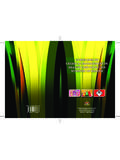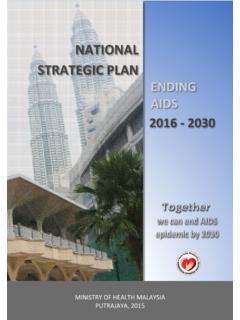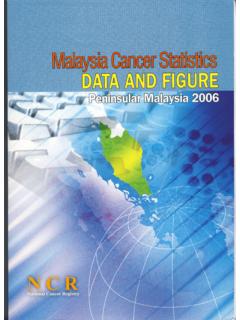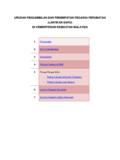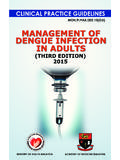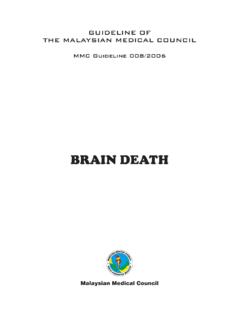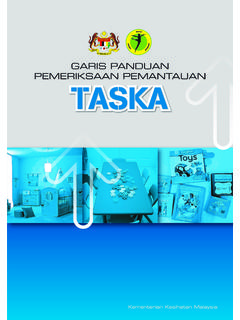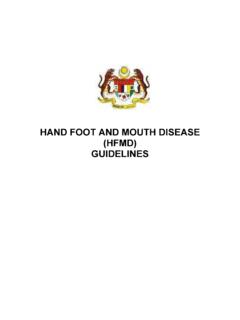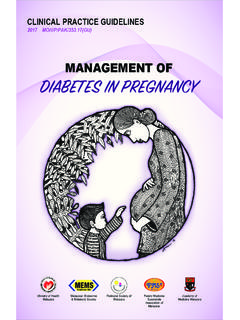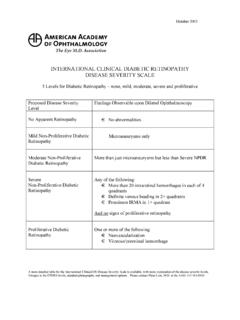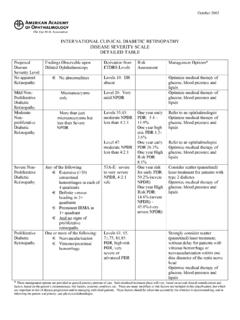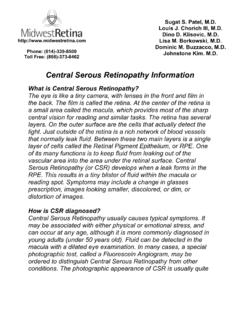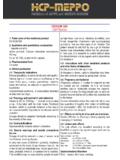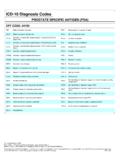Transcription of SCREENING OF DIABETIC RETINOPATHY - moh.gov.my
1 SCREENING OF DIABETIC RETINOPATHY . SCREENING OF DIABETIC RETINOPATHY . STATEMENT OF INTENT. These clinical practice guidelines (CPG) are meant to be guides for clinical practice, based on the best available evidence at the time of development. Adherence to these guidelines may not necessarily guarantee the best outcome in every case. Every healthcare provider is responsible for the management of his/her unique patient based on the clinical picture presented by the patient and the management options available locally. These guidelines were issued in 2011 and will be reviewed in 2015 or sooner if new evidence becomes available. CPG Secretariat Health Technology Assessment Section Medical Development Division Ministry of Health Malaysia 4th Floor, Block E1, Parcel E.
2 62590 Putrajaya Electronic version available on the following website: SCREENING OF DIABETIC RETINOPATHY . TABLE OF CONTENTS. LEVELS OF EVIDENCE SCALE AND GRADES OF RECOMMENDATION i GUIDELINES DEVELOPMENT AND OBJECTIVE ii GUIDELINES DEVELOPMENT GROUP v REVIEW COMMITTEE vi EXTERNAL REVIEWERS viii ALGORITHM FOR SCREENING OF DIABETIC RETINOPATHY TO PREVENT BLINDNESS ix 1. INTRODUCTION 1. 2. EPIDEMIOLOGY OF DIABETES MELLITUS AND DIABETIC RETINOPATHY 2. Prevalence and Incidence of Diabetes Mellitus 2. Adults 2. Children and Adolescents 2. Prevalence and Incidence of DIABETIC RETINOPATHY 3. Prevalence of Blindness and Sight Threatening DIABETIC RETINOPATHY 3. 3 RISK FACTORS 4.
3 4. DIABETIC RETINOPATHY GRADING 5. 5. ASSESSMENT OF DIABETIC RETINOPATHY 7. SCREENING Tools 7. Sensitivity and Specificity of DIABETIC RETINOPATHY SCREENING Tools 7. Agreement between Non-mydriatic Fundus Camera versus 8. Ophthalmoscope and Mydriatic Fundus Camera Automated DIABETIC RETINOPATHY Grading 8. Pupillary Dilatation 9. Examination and Grading of DIABETIC RETINOPATHY by Healthcare Professionals 9. SCREENING OF DIABETIC RETINOPATHY . 6. EXAMINATION SCHEDULE 11. Timing of First SCREENING 11. Follow-up Examination Schedule 13. Referral Criteria to Ophthalmologist 14. 7. TREATMENT FOR DIABETIC RETINOPATHY 15. Current Treatment Modalities 15. Modifiable Risk Factors in Reducing Progression of DIABETIC RETINOPATHY 16.
4 8. IMPLEMENTING THE GUIDELINES 17. Existing Facilitators and Barriers in Applying Recommendations 17. Potential Resource Implications in Applying Recommendations 18. REFERENCES 20. Appendix 1 SEARCH TERMS 25. Appendix 2 CLINICAL QUESTIONS 26. Appendix 3 FUNDUS APPEARANCE ACCORDING TO DIABETIC RETINOPATHY STAGES 27. Appendix 4 LIST OF HEALTH CLINICS WITH FUNDUS CAMERA IN MINISTRY OF HEALTH 2011 29. LIST OF ABBREVIATIONS 34. ACKNOWLEDGEMENT 35. DISCLOSURE STATEMENT 35. SOURCES OF FUNDING 35. SCREENING OF DIABETIC RETINOPATHY . LEVELS OF EVIDENCE. Level Study design I Evidence from at least one properly randomised controlled trial Evidence obtained from well-designed controlled trials without II -1.
5 Randomisation Evidence obtained from well-designed cohort or case-control analytic II-2. studies, preferably from more than one centre or group Evidence from multiple time series with or without intervention. Dramatic results in uncontrolled experiments (such as the results of II-3. the introduction of penicillin treatment in the 1940s) could also be regarded as this type of evidence Opinions of respected authorities based on clinical experience;. III. descriptive studies and case reports; or reports of expert committees SOURCE: US / CANADIAN PREVENTIVE SERVICES TASK FORCE. GRADES OF RECOMMENDATION. At least one meta analysis, systematic review, or RCT, or A evidence rated as good and directly applicable to the target population Evidence from well conducted clinical trials, directly applicable to the target population, and demonstrating overall consistency B.
6 Of results; or evidence extrapolated from meta analysis, systematic review, or RCT. Evidence from expert committee reports, or opinions and /. C or clinical experiences of respected authorities; indicates absence of directly applicable clinical studies of good quality SOURCE: MODIFIED FROM THE SCOTTISH INTERCOLLEGIATE GUIDELINES NETWORK (SIGN). Note: The grades of recommendation relates to the strength of the evidence on which the recommendation is based. It does not reflect the clinical importance of the recommendation. i SCREENING OF DIABETIC RETINOPATHY . GUIDELINES DEVELOPMENT AND OBJECTIVES. GUIDELINES DEVELOPMENT. The Development Group for these Clinical Practice Guidelines (CPG) was from the Ministry of Health (MOH) and Ministry of Higher Education.
7 They consisted of ophthalmologists, a paediatrician, an obstetrician & gynaecologist, a public health physician, a family medicine specialist, an optometrist, an assistant medical officer and a nursing sister. There was active involvement of the Review Committee during the process of development of these guidelines. Literature search was carried out at the following electronic databases: Guidelines International Network (G-I-N); Centre for Reviews and Dissemination (CRD);. PubMed; Ovid Medline, EBM Reviews - Cochrane Database of Systemic Reviews, EBM Reviews - Health Technology Assessment, Journals full text via OVID search engine (refer to Appendix 1 for Search Terms).
8 In addition, the reference lists of all retrieved articles were searched to identify relevant studies. Experts in the field were also contacted to identify further studies. All searches were conducted between September 2009 and January 2011. Future CPG updates will consider evidence published after this cut-off date. The details of the search strategy can be obtained upon request from the CPG Seretariat. Reference was also made to other guidelines on DIABETIC RETINOPATHY such as The American Academy of Ophthalmology Preferred Practice Pattern DIABETIC RETINOPATHY (2008) and National Health and Medical Research Council (NHMRC). Australia Guidelines for the Management of DIABETIC RETINOPATHY (2008).
9 These CPGs were evaluated using the Appraisal of Guidelines for Research and Evaluation (AGREE) prior to them being used as references. The clinical questions were developed under three major subtopics and members of the Development Group were assigned individual questions within these subtopics (refer to Appendix 2 for Clinical Questions). The group members met a total of 16 times throughout the development of these guidelines. All literature retrieved was appraised by at least two members and presented in the form of evidence tables and discussed during Development Group meetings. All statements and recommendations formulated were agreed upon by both the Development Group and Review Committee.
10 Where evidence was insufficient, the recommendations were made by consensus of both groups. These CPG are based largely on the findings of systematic reviews, meta-analyses and clinical trials, with local practices taken into consideration. ii SCREENING OF DIABETIC RETINOPATHY . The articles were graded using the US/Canadian Preventive Services Task Force Level of Evidence (2001), while the grading of recommendation in these guidelines was modified from grades of recommendation of the Scottish Intercollegiate Guidelines Network (SIGN). The draft guidelines were posted on the MOH Malaysia official website for comment and feedback. It had also been presented to the Technical Advisory Committee for CPG and the HTA-CPG Council, MOH Malaysia for review and approval.
